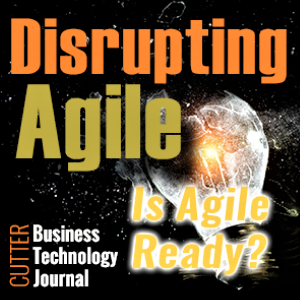Just as my trainer says in the gym, “Use it or lose it!” the same can be true of enterprise agility in the digital era. The staid organization that does not flex and align with market trends becomes fat and, just as with humans, rapid movement becomes more difficult. Traditionally in the context of enterprise success, size mattered; the more significant the organization grew, the more common the perception of success also became. Now, however, with the digital revolution, it is not just size, but the enterprise’s ability to rapidly change direction while continuing to provide excellent products and services to customers that is most admired.
So, what are the organizational exercises — the squats and the pushups for an enterprise — that make a difference? Some of these, like adopting a new exercise regime, could be quite radical. Choosing new ways of working, changing organizational precepts, and focusing on continuous improvement could be some of the fundamental changes.
In most enterprises, people and processes are organized around functions and specialization in skills, applications, or professional disciplines. Since 1985, when Michael Porter’s book Competitive Advantage introduced the concept of value chains, we have seen how parts of an organization link together to create value for customers. Porter’s generic model has been refined by the value stream mapping technique used in Lean. A value stream provides a unique view of the tasks or events necessary in an enterprise for a product or service to reach a customer. Each enterprise creates a series of unique operational value streams that deliver products and services to customers in its marketplace. Taking this concept another step forward, we can see that organizational strategy is implemented by the creation, amendment, or cessation of operational value streams.
Operational value streams deliver the operational intent — the strategy — of an enterprise. The act of changing, improving, and creating new operational value streams also has a set of tasks, forming a development value stream. Developing the software development value stream is a focus of Agile product delivery. It has widely recognized that DevOps is a delivery value stream.
Gerhard J. Plenert described value stream mapping as a technique in his book Lean Management Principles for Information Technology. To summarize, an enterprise has two sets of value streams: the operational value streams that deliver the business functions that enable strategy and development value streams that alter business functions. To change or redirect strategy requires functional value stream changes produced by development value streams.
-
Operational value streams deliver the strategy.
-
Development value streams deliver enterprise agility.
More often than not in the digital era, the creation of new enterprise capabilities uses Agile techniques. Most enterprises use Scrum or a derivation thereof. In Scrum, the customer is represented by a product owner.
The Scrum Guide describes a Scrum product owner as being responsible for maximizing the value of the product resulting from the work of a development team. Value is created by the delivery of features and business requirements by a development team. The delivery process may vary widely across development teams and organizations. The Scrum Guide describes the product owner as the sole person responsible for optimizing the value of the work of the development team. They perform this role by managing the list of work to be completed on the product backlog. Scrum is essentially a generic internal-to-the-team process. However, if operational value streams deliver a strategy, then it should be recognized that product owners change these. Certifications and training for product owners make scant reference to the impact of their decisions on the operational value stream and therefore on enterprise efficiency. If an enterprise is to become Agile, then it needs to join up the actions of the product owners with the operational value stream reengineering or there will be waste.
Mike Rother and John Shook, in Learning to See, advocate the role of a value stream manager. I like the term value engineer, as value engineering is a systematic method to improve the function-to-cost ratio of the product or service. The value stream manager role is the person responsible for the design of the value stream, planning changes, and monitoring its efficiency. Designated owners for each value stream will negate the risks of waste and inefficiency.
In his book, Accelerate, John Kotter suggests that traditional hierarchical organizational structures prevent an enterprise from quickly responding to market changes or opportunities through the bureaucracy they impose. The structures and processes used for decades with success to run and improve an enterprise no longer work efficiently in the Digital Era. Kotter suggests that what is needed is a parallel organizational operating system; one that continually assesses the business model identifies challenges and opportunities and can rapidly effect change to the value streams. Kotter calls the second operating model an Agile network-like structure.
Kotter recommends that an organization employ both operating systems. For many executives, this may infer simply bolting structures on the side of their existing hierarchy. The question is which operating system should have ultimate control, and what should be the function of each structure.
If agility is the goal, then the enterprise should focus on its network organization; managing its operational value streams (how products and services get to its customers efficiently). The network organization is also instrumental in how the enterprise implements changes to these value streams. Meanwhile, the hierarchical organization provides shared services and governance for the network. In this way, the hierarchy acts as a servant leader to the network.
Kotter states that digital era organizations should seek competitive advantage without disrupting their operations. He infers controlled, rapid refinement rather than radical, seismic, unrestrained change. Rapid improvement aligns with the incremental plan-do-check-adjust used in Agile but also caters for the pivot-without-remorse when things are tried but don’t work out.
An Agile team is organized so that it has all the skills and capabilities to deliver the entire customer proposition. While this concept is attached to software engineering practices, the same can be said for operational processes, which can be designed around customer journeys or value streams. Having the operational team members and the change delivery teams aligned to a value stream allows an enterprise to directly compare operational costs with revenues. It enables the enterprise to optimize the end-to-end efficiency of the value stream with a focus on customer satisfaction.
Agile development teams can then develop the value stream under the guidance of the value stream manager. Having development teams aligned with value streams is a foundational principle of the Scaled Agile Framework. Aligned teams build a knowledge of the value stream over time and obtain a clear line of sight between their goals and the objectives of the value stream.
So why use it or lose it? An Agile enterprise can rapidly respond to changing market circumstances or opportunities while delighting its customers. To have these capabilities, it has built an organization, policies, and processes that facilitate its speed of change. An enterprise will lose these capabilities if it doesn’t recognize value streams. In that case, the organization will, as the pace of change accelerates, become more dysfunctional and less able to deliver high-quality products and services. If the enterprise doesn’t develop the capability to rapidly alter the business model to meet challenges and opportunities in the digital era, then it will quickly become irrelevant!
Disrupting Agile: Is Agile Ready?
This issue of Cutter Business Technology Journal (CBTJ) highlights how the status quo focus on agile practices is proving to be insufficient. Available for purchase in the Cutter Bookstore.




